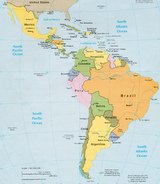What if we threw out all the illegal immigrants?
Overnight, some industries would become desperate for workers. The biggest beneficiaries would be low-skilled American workers. The big losers might surprise you.
advertisement
This is one in an occasional series on financial what-ifs.
At least 12 million illegal immigrants live in the U.S. Most pick crops, wash dishes, build houses, cut lawns and do other jobs for between $6 and $15 an hour. They make up about 5% of the total U.S. work force. But …
What if we threw them all out?
Lettuce and strawberries would rot in the fields. Dirty dishes would pile up in restaurants. Thousands of farmers and builders would go bust. Predator aircraft drones would prowl the Mexican border. And chunks of Los Angeles and Houston would look like ghost towns.
The biggest losers would be middle-class families with two working parents, living in high-immigrant states such as California, Texas, Florida or New York. Why? They would pay more for food, housing, entertainment and child care as a shortage of low-skilled workers drove up some wages, and therefore, some prices. Meantime, their own pay would remain the same. What's more, the ripple effect of thousands of businesses shrinking or closing for lack of staff might put one of the parents out of a job. Not to mention the garbage collection going to pot and no one to polish the missus' nails.
The winners, for a change, would be the low-skilled unemployed, living just about anywhere -- if they were willing to move. Of the 12 million illegal immigrants, about 8 million are employed, mostly in low-skill jobs. The U.S., meantime, has about 22 million less-educated jobless adults, many of them blacks and legalized Hispanics, according to a 2008 report from the Center for Immigration Studies, a research group based in Washington, D.C.
Economists say if these people agreed to bone meat or install insulation, they could earn 6% to 10% more than the deported workers, as wages rose to lure new workers. That could mean $18,000 to $30,000 in pay a year.And the economy? Short term, the effect of lost manpower and spending by illegal immigrants would be "devastating" or cause "some temporary dislocation," depending on whom you ask.
Are Americans willing to do these jobs?
Ray Perryman, the president of The Perryman Group, an economic analysis firm in Waco, Texas, calculates our $14 trillion economy would suffer $652 billion in lost output -- a dramatic 4.6% slice off gross domestic product. He predicts tens of thousands of businesses would close. Robert Rector, a senior research fellow at The Heritage Foundation, a conservative think tank in Washington, predicts perhaps a 1% slip in GDP.| Illegal population by state | |||
|---|---|---|---|
State | Estimate | State | Estimate |
California | 2,830,000 | Georgia | 490,000 |
Texas | 1,640,000 | New Jersey | 430,000 |
Florida | 980,000 | North Carolina | 370,000 |
Illinois | 550,000 | Washington | 280,000 |
New York | 540,000 | All other states | 2,950,000 |
Arizona | 500,000 | Total | 11,560,000 |
Source: Department of Homeland Security
Why the big difference in opinion? Because people are hard to predict.
Just how quickly would Americans fill the vacated jobs? And at what pay rate? Perryman points to Texas, where he says there are more than 1 million illegal workers, but only 450,000 unemployed residents. "If you do the math, it just doesn't work," he says. He doubts that many needy Virginians would move to Texas for often-grueling, low-paying jobs.
Rector disagrees. He says it would take time for "Cousin Fred" in Texas to phone up his jobless mates in Virginia, but, "There are a lot of people who work for less than $20,000 a year." And they would move for a job.
Still, until the unemployed did jump in their Hyundais to head south, several industries in high-immigrant states would have a terrible time. Some are listed below. The figures in parentheses show the percentage of illegal workers in each industry's work force, as calculated by the Pew Hispanic Center in Washington. The figures are nationwide; in some localities, they would be far higher.- Home help (21%): Los Angeles would still have its sunshine, but there'd be far fewer helping hands to clean floors, cook dinner and shush the kids. Not to mention in New York, Chicago, Houston, Phoenix and Miami. Some working parents might have to quit their jobs to care for the kids or break the family piggy bank to attract a housekeeper from a neighbor.
- Farming (13%): "Agriculture would come to a screeching halt," says Nicole Rothfleisch, executive director of the Imperial County Farm Bureau in Southern California. She says El Centro, the county seat, has the highest unemployment in the state (18%). But farmers can never find enough local help. Pay is $9 an hour, and the summer temperatures can hit 110 degrees. The locals, she says, "want cushy jobs with air conditioning." Economists say many farmers would go broke as billions of dollars' worth of crops lay unpicked. Farms would merge and switch to crops that can be picked mechanically, like round lettuce or oranges used solely for juice.
-------------------------------------------------
Ir al Sitio principal Escritos críticos / Ensayos
www.majfud.50megs.com
Reflexiones sobre nuestro tiempo
-------------------------------------------------


 Apples and immigrants
Apples and immigrants



1 comentario:
What's up every one, here every one is sharing these kinds of familiarity, therefore it'ѕ fаstіdious
to read this weblog, and I useԁ to go to ѕee thiѕ webρage dailу.
my web blog mario party
Publicar un comentario